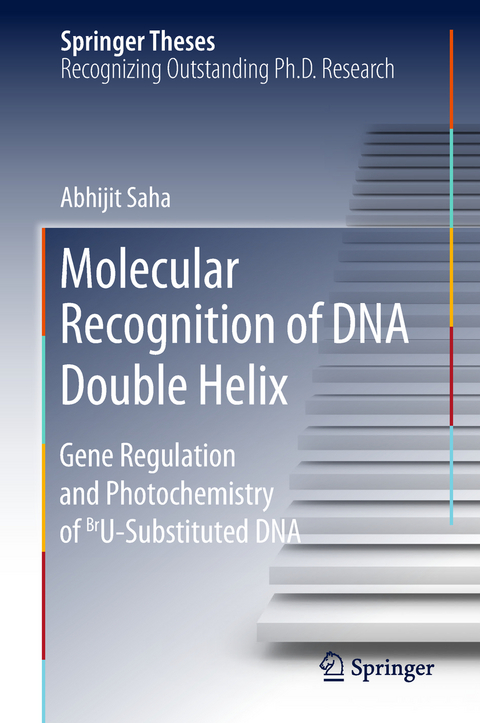
Molecular Recognition of DNA Double Helix
Gene Regulation and Photochemistry of BrU Substituted DNA
Seiten
2018
|
1st ed. 2018
Springer Verlag, Singapore
978-981-10-8745-5 (ISBN)
Springer Verlag, Singapore
978-981-10-8745-5 (ISBN)
In this book, the molecular recognition of DNA using small molecules is discussed, with a study of the photochemistry of BrU-labeled DNA.
In this book, the molecular recognition of DNA using small molecules is discussed, with a study of the photochemistry of BrU-labeled DNA. The purposes of the study were to develop small molecules for regenerative medicine, to develop a method to detect the recognition site of small molecules, and to detect the most important biological phenomena using the photochemistry of BrU-labeled DNA. The study began with the design and development of small molecules that can induce pluripotency genes. To deal with the important issue of cell permeability of the original compound, a new analogue of the original with improved gene expression was designed and synthesized. Using the photochemistry of BrU-labeled DNA, crucial biological phenomena such as cooperativity between transcription factors were detected. For the first time, the cooperativity was examined by excess electron transfer assay. DNA was also studied very carefully in order to understandthe mechanism of the double-strand break in the UVA micro-irradiation technique. The mechanism of the double strand remained untouched. Nevertheless, the double-strand break mechanism was clearly demonstrated by Hoechst dye, as shown in this book.
In this book, the molecular recognition of DNA using small molecules is discussed, with a study of the photochemistry of BrU-labeled DNA. The purposes of the study were to develop small molecules for regenerative medicine, to develop a method to detect the recognition site of small molecules, and to detect the most important biological phenomena using the photochemistry of BrU-labeled DNA. The study began with the design and development of small molecules that can induce pluripotency genes. To deal with the important issue of cell permeability of the original compound, a new analogue of the original with improved gene expression was designed and synthesized. Using the photochemistry of BrU-labeled DNA, crucial biological phenomena such as cooperativity between transcription factors were detected. For the first time, the cooperativity was examined by excess electron transfer assay. DNA was also studied very carefully in order to understandthe mechanism of the double-strand break in the UVA micro-irradiation technique. The mechanism of the double strand remained untouched. Nevertheless, the double-strand break mechanism was clearly demonstrated by Hoechst dye, as shown in this book.
Dr. Abhijit SAHAInstitut Curie, Campus Universitaire, Orsay, France
1. Overview of DNA minor groove binding synthetic small molecules and photochemistry of BrU substituted DNA.- 2. Synthesis and Biological Evaluation of Targeted Transcriptional Activator with HDAC8 Inhibitory Activity.- 3. Chemical Modification of a Synthetic Small Molecule Boosts its Biological Efficacy against Pluripotency Genes in Mouse Fibroblast.- 4. Development of a novel photochemical detection technique for the analysis of polyamide binding sites.- 5. Examining cooperative binding of Sox2 on DC5 regulatory element upon complex formation with Pax6 through excess electron transfer assay.- 6.UVA irradiation of BrU-substituted DNA in the presence of Hoechst 33258.
| Erscheinungsdatum | 18.04.2018 |
|---|---|
| Reihe/Serie | Springer Theses |
| Zusatzinfo | 50 Illustrations, color; 8 Illustrations, black and white; XVI, 114 p. 58 illus., 50 illus. in color. |
| Verlagsort | Singapore |
| Sprache | englisch |
| Maße | 155 x 235 mm |
| Themenwelt | Naturwissenschaften ► Biologie ► Biochemie |
| Naturwissenschaften ► Biologie ► Zellbiologie | |
| Naturwissenschaften ► Chemie ► Organische Chemie | |
| Schlagworte | Artificial transcription activator • BrU substituted DNA • Excess electron transfer • HDAC inhibitor • Photochemistry of substituted DNA |
| ISBN-10 | 981-10-8745-8 / 9811087458 |
| ISBN-13 | 978-981-10-8745-5 / 9789811087455 |
| Zustand | Neuware |
| Haben Sie eine Frage zum Produkt? |
Mehr entdecken
aus dem Bereich
aus dem Bereich


